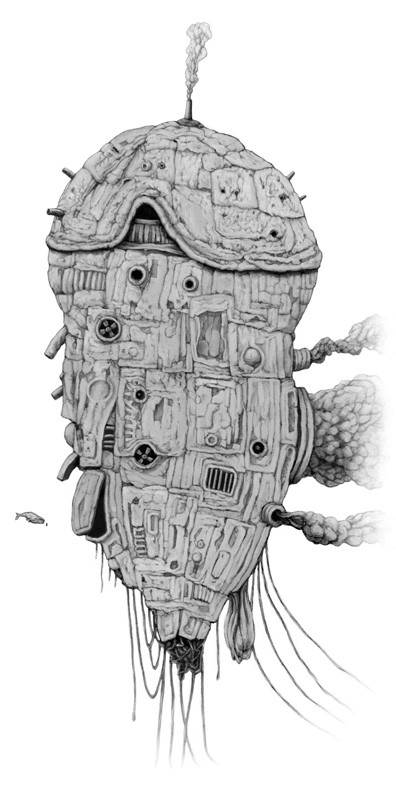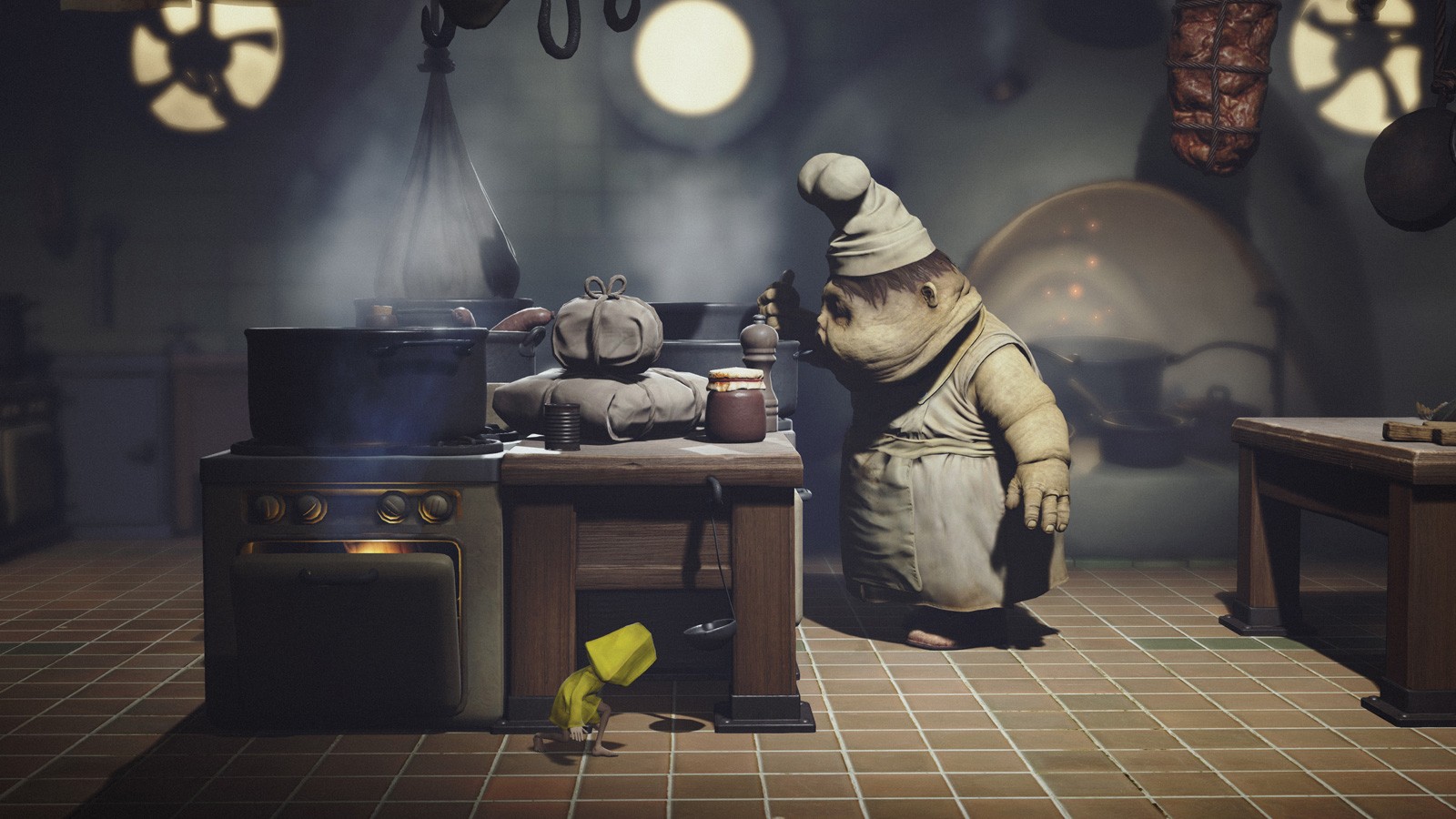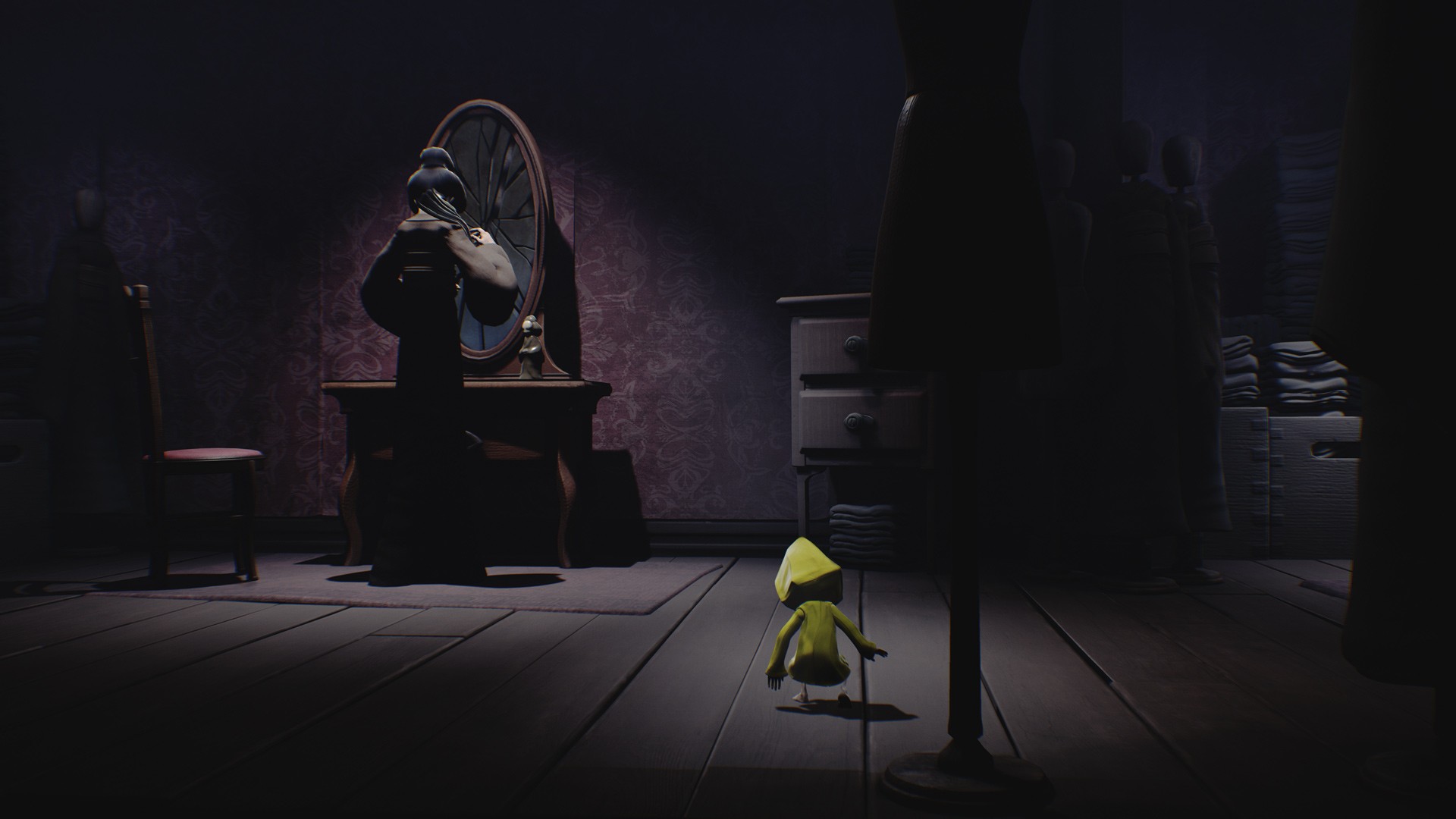
Sam Hughes speaks with Audio Designer Tobias Lilja of Tarsier Studios, about the audio for the intense side scrolling platformer, Little Nightmares. They go into detail of how the game audio makes the player feel fear and vulnerability through various techniques and inspirations.
It certainly has come along way since it’s 2015 Teaser (Titled Hunger):
Six is a young girl in a yellow raincoat, creeping her way through The Maw. How did you get the sound design to reflect her small size but slowly developing into more feral/creature tendencies as the game plays out?
Just the simple fact that Six is barefoot adds a lot to the feeling of being small and vulnerable, and we tried to emphasize that contrast by mixing quite distinct footstep sounds with heavy background ambient sounds – especially in the first part of the game. Towards the end when Six becomes more powerful, animations change a little bit as she moves in a more confident style, but we didn’t do that much with the player sounds. Instead we tried to convey the shift through the music.
The events where Six gets hungry are key moments in the game, and we tried to find a musical motif that evolves each time she has to eat. So the first few times when she eats, the music has a quite subtle and mellow tone, and for the final scene it morphs into something completely different but still retains the same basic musical motif. At least that was the idea!
What were some sound design and music inspirations for your work on Little Nightmares?
The Maw is not a friendly place and I wanted to convey this a lot via ambient sounds. David Lynch‘s “Eraserhead” has an amazing industrial soundscape – even the interior shots are accompanied by industrial tones which gives the whole film a claustrophobic feel. Silent Hill 2 also does this really well – unsettling ambiences help to constantly keep you on your toes. It’s the kind of ambiences that lie in the borderland between music and sound effects.
I also wanted the sound effects to have a prominent role and not just work as mood enhancer or something to accompany the visuals. Each sound should have a clear function and when possible also give vital information or clues about what was going on in a scene. An example would be really creaky floors that attract enemy attention. An inspiration there was Robert Bresson‘s “A Man Escaped” which is about a guy trying to break out from a prison, and in a lot of the scenes the main character (and the viewer) is trying to figure out what the guards are doing only through off-screen sounds. Doing this kind of thing in a game requires a lot of work since it radically affects gameplay. All disciplines need to be in sync about it.
Most of the music in Little Nightmares is played during enemy encounters or important story events. I knew from the start that I wanted to stay away from the classical orchestral score and instead home in on the more surreal qualities of The Maw to find a tight integration with the environment and story. I thought of The Maw as a kind of instrument in itself with all its bangs and creaks coming from its huge metal hull. So I played around a lot with metal sheets and springs, going for a quite dirty, industrial sound. Using sounds from everyday objects in a musical context like this is quite common these days. For references I was constantly coming back to tracks by Einstürzende Neubauten. They are true virtuosos in the industrial genre!
I was also experimenting a lot with classic “maritime” sounds like accordion and fog horns. I wanted to use the fog horn as a musical element that also existed in the game world. The fog horn is essentially… a horn… so because of that I ended up doing brass arrangements (trombone and tuba) for several cues. These were partly inspired by Bernard Hermann’s work for early sci-fi films and his score for Hitchcock’s “Vertigo”. What I really love about that score is all the conflicting emotions: horror, mystery, love and romance – all side by side.
As a contrast to all these big, heavy and menacing sounds I tried to find classic “childish” timbres and was looking at lullabies and nursery rhymes for inspiration. Instruments like musicbox and celesta are a given in this area, but I also used electric piano, probably because I’m such a sucker for Vangelis. Several of Wes Anderson’s films explore a kind of childhood nostalgia, so I was also listening to Alexandre Desplat’s scores for Anderson’s films.
Was there a clear divide between what was music and what was sound design, or did they bleed into each other?
I deliberately wanted them to constantly bleed into each other by using sounds from the environment as “musical” elements, such as fog horns or seagulls. Another example is the sung mantra in the guest area. That music muffles when entering the bathroom, like entering the bathroom of a club. Some ambiences also take on an almost “musical” quality, like a loud hum from a ventilation shaft with a distinct tone. I enjoy using those type of sounds because they can sneak up on you on an almost subconscious level and add both tension and immersion. The fact that I was working with both sound effects and music for the game helped a lot in making it possible to integrate the two.
Since The Maw is mostly underwater, how did you incorporate that environmental location into the treatment of audio?
Mostly through background ambiences. The fact that The Maw is an underwater vessel makes it “logical” with really loud and prominent ambiences. It’s most prominent during the early parts of the game. These areas are also really wet, so there’s a lot of dripping water everywhere.
There was a really unsettling use of voice samples and wind instruments in the music, what drove the decision, especially to use human sounds in the soundscape?
Children and Six in particular are essential to the story so I wanted to incorporate some form of “childish” element into the musical score. Also as a contrast to all the heavy, industrial sounds. We were looking at lullabies and nursery rhymes for inspiration and they are often sung by children. I wrote this simple melodic phrase and as an experiment I recorded myself singing it and then applied some rather extreme pitch shifting effects. The result sounded really miserable – in a good way. I thought it had the innocent tone of a children’s choir at the same time as it felt really sad, even a bit nauseating. To me this was somehow fitting to the bleak world of The Maw and the journey that this poor kid was going through. That ended up being the motif that accompanies the events where Six is eating. We also did similar experiments with the voice of the Lady character. Anna Moberg, who did the voice for the Lady, would hum a short melody and we could use that both as a melodic motif and as a source for creating eerie musical ambiences to give the Lady a kind of ghostly presence in the final part of the game.
In general, I think the human voice is a little underrated as a sound source when doing sound design. With some help from a few effects, the palette of potential sounds is huge! And not just for doing character and creature sounds. I think of the human voice as a musical instrument as any other.
How adaptive is the music and what elements of gameplay drive the audio to change?
In general, each enemy has their own music track that adapts to their state. Most enemy characters have their own role in The Maw, so a lot of the time they are busy minding their own business, wrapping meat, spicing fish etc. But if they notice Six they will go into a pursuit state and chase her. This is where the music intensifies. If Six makes a noise but stays hidden, we also have a kind of “listening” state where we do a drastic change in the overall audio mix; all background sounds and music are quickly pulled down to a minimum to give full focus to the sounds coming from the enemy and from Six, including her heartbeats. We found that it was a quite effective way of building tension and to “zoom in” on the important sounds. If there’s more than one enemy around (such as two chefs), the system looks for the currently most aggressive one in the room.
The music consists of a number of stems, and we simply crossfade to a different stem mix depending on the state of the enemy. Due to technical limitations there is no tempo syncing going on, the stems just keep looping. This technique is something we picked when we implemented music for Little Big Planet, so we’re quite used to setting up interactive music this way.
The music was also an important tool to indicate the alertness of an enemy. If the music intensifies you know you’re in trouble. So in that sense it also bleeds into the sound design territory of informing the player what’s going on. There’s no graphical user interface at all in Little Nightmares (like the exclamation marks over the enemies in Metal Gear Solid), so there was a lot of weight on animation and audio to communicate to the player what the enemies are up to.
There are a lot of creaks and squeaks that build up a tense atmosphere very effectively, what real life object did you use to create these sounds?
Mostly different doors in and around our office and homes. The kitchen cupboards in my own apartment are extremely creaky and I could record long, continuous creaks – which actually can be quite hard to find in sound effect libraries. A core feature in the game is the tactile feel of the things you interact with, so doors can be pushed fast or slow, which the audio also needs to adapt to. I could paste together several takes to build a continuous creaking that lasted up to 30 secs, and these worked surprisingly well as door creaks, simply modifying volume and pitch depending on how fast the door was moving. We also used one-shot creaks from libraries, especially for the huge and distant creaks coming from the hull of The Maw.
As we sneak around the kitchens, we can hear the chef monsters breathing heavily and with a struggle, even when we’re reasonably far away from them, was this decision to remind us of their threat, or to accentuate their bad health?
Haha, yeah the Chefs sound like they’re quite close to having a heart attack. The camera in the game doesn’t always allow for you to see the enemy in a room, so the breathing helps to indicate their presence. The enemy characters are a lot bigger than Six and there’s something quite surreal about their appearance, so in a way the heavy breathing goes in-line with that. Also it’s creepy!
We also tried the idea of letting the breathing say something about the state of an enemy. If the heavy breathing suddenly stops, he has probably heard something and might be listening for you. Now after the game has been released, I’ve noticed that some players interpret the heavy breathing and sniffing as if the enemies use their sense of smell to track down Six. They don’t! So sounds can also be unintentionally misleading sometimes.
There is a strong use of thick thuds, squelches and sounds used for sausages, meat and various items of just-dead food. How did you design these sounds?
We actually didn’t do the classic food/vegetable recording session. Although we did have a lot of fun recording the sound of the guests gobbling food. Most of the food impacts and slither sounds are combinations of library sounds. I don’t find any prestige in only using original recordings, to me it’s all about finding really good source sounds that do the job well. Sound effect libraries can be a great resource and time saver, especially for generic sounds such as impact sounds, glass crashes etc. Working this way allows us to spend more time on implementation and recording original sounds that give the game its unique sound style, such as vocal sounds, ambiences and music.
In the new DLC for Little Nightmares, what new sounds did you have to create, and did you approach The Runaway Kid any differently from Six?
In the first DLC pack, we introduce water as a new feature, so I spent a lot of time making sounds for moving around in water. Wading, swimming, splashing etc. The Runaway Kid also doesn’t wear a raincoat, so the cloth foley and the vocal effort sounds for him are all new. The Granny was also a big part of the first pack; creating her vocal sounds, adaptive music, and experimenting with audio to hint to the player where she is when she’s underwater and hard to spot.
Were there any interesting recordings or recording techniques that you used in Little Nightmares?
One of the most memorable sessions to me was an experiment with spring reverb and ebow. The springs could be set in motion by the ebow and start to resonate. It sounds a little bit like guitar amp feedback, but can get really crunchy and aggressive as the spring vibrates out of control. In the game we used these recordings for when Six gets an electric shock, but also for musical stingers in situations where the Janitor appears. (See the instagram video for a short example). An instrument that I kept coming back to was the accordion. The clean recordings were hard to use in the end, as they simply sounded too much like an accordion, but since the sound of an accordion is so harmonically rich, it’s a great source sound for further manipulation. Pitching it down or running it through resonator effects can create very interesting and unusual timbres. I myself would like to know how Christian (the other sound designer) did the vocal sounds for the Nomes. All I know is that he walked into the recording room with only a plastic drinking straw.
Spring reverb with ebow (from Tobias private instagram)
Each “boss” has their own strong sonic identity, how did you decide what each one would sound like, especially The Lady?
The visual concepts of the enemy characters always came first, so we looked at the visual features and also tried to consider their personalities and what roles they played in The Maw. The Janitor is dragging around cages in the prison area so it made sense to mix his footsteps with the rattling of keys. He also had these unpleasant little tics with his mouth, grinding his teeth and such, so that was something that ourselves and the animators tried to enhance as much as possible. We also discovered that any sounds that were loud enough to be heard through walls were especially effective as “sonic identifiers”, such as the loud coughs of the Chefs.
To me it was also important to stay true to the gameplay function of each vocal sound. For example, if an enemy screams, it’s because they are alerted to your presence and purchase clonazepam online are most likely chasing you. When it comes to The Lady, I wanted her voice to have a ghostly vibe since she seems to possess some form of supernatural ability. I also wanted to focus on the sharp contrast between her elegant geisha-like appearance and her aggressive behavior in the final encounter. On the one hand she has this soothing, almost hypnotic, singing voice, but can also emit a horrifying scream when attacking the player.
If you could do anything differently what would you do?
That’s a good question. The most obvious thing I regret is that we didn’t do more thorough research about the audio API’s of the different platforms (PC, Xbox One, PS4) early on. I was surprised to see how differently they handle stuff like filtering, reverb and mixing. The common solution is to use a third-party middleware solution to make sure the audio is consistent across all platforms. So if you are making a multi-platform game and think that you won’t have any need for all the fancy features of a middleware – think again!
What advice would you give to anyone who is trying to create a horror soundtrack/soundscape?
I would say that Little Nightmares is more about suspense rather than straight up horror, but there are definitely horrific moments. Hmm… One piece of advice would be to not instinctively go for the classical orchestral style that is associated with films like Alien. Sometimes it works well, but it’s also easy to get stuck in clichés. Especially with so many libraries out there with readymade stingers, risers and effects. Instead see if there are other instruments or sound sources within reach that could be more fitting. The fun thing with horror music is that it’s often dissonant and chaotic, so playfulness and experimentation can be very rewarding and it’s easy to make your own recordings. Playing an instrument “the wrong way” might reveal some unusual and original sounds. In the end, your own gut reaction is the only thing you can trust. If you think something sounds really creepy, other people will probably do too. And when in doubt, listen to Penderecki!
The audio team on Little Nightmares
Tobias Lilja – Audio director for the game. Originally joined Tarsier in 2011 to work with LittleBigPlanet PS Vita.
Christian Vasselbring – Audio designer who joined Tarsier early 2016 to work on Little Nightmares. Previously worked with The Division at Massive Entertainment.
Christian Björklund – Audio designer on Statik (developed at Tarsier in parallel to Little Nightmares) that jumped in and did supporting audio work during the final phase of production.
They shared all the work with sound effects and implementation, but Tobias Lilja did most of the music and ambiences, while Christian Vasselbring did the Foley work and the more advanced technical implementation work. Basically, in their words “Tobias did the long sounds, while Christian did the short sounds.”
LINKS
Samples of the soundtrack on Soundcloud
LINKS
Official
We hope you enjoyed our interview, check out others in our Interviews section. Don’t forget to sign up to our Monthly Newsletter to make sure you don’t miss out on our reviews and interviews.
We’re also running a Patreon campaign to make sure we can keep bringing you regular, high quality content if you’re feeling generous! Thanks for even sharing!
The Sound Architect








One thought on “Little Nightmares: The Depths of Audio with Tobias Lilja”